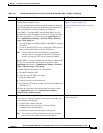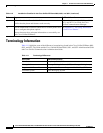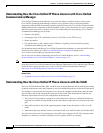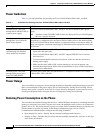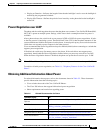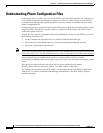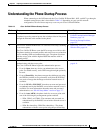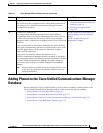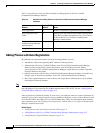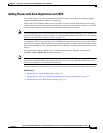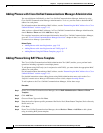
2-7
Cisco Unified IP Phone 8961, 9951, and 9971 Administration Guide for Cisco Unified Communications Manager 8.5 (SIP)
OL-20861-01
Chapter 2 Preparing to Install the Cisco Unified IP Phone on Your Network
Understanding the Phone Startup Process
Understanding the Phone Startup Process
When connecting to the VoIP network, the Cisco Unified IP Phone 8961, 9951, and 9971 go through a
standard startup process that is described in
Table 2-3. Depending on your specific network
configuration, not all of these steps may occur on your Cisco Unified IP Phone.
Table 2-3 Cisco Unified IP Phone Startup Process
Task Purpose Related Topics
1. Obtain power from the switch.
If a phone is not using external power, the switch provides in-line power
through the Ethernet cable attached to the phone.
• Adding Phones to the Cisco
Unified Communications Manager
Database, page 2-9.
• Resolving Startup Problems,
page 12-1.
2. (For a Cisco Unified IP Phone 9971 in a wireless LAN only) Scanning
for an access point.
The Cisco Unified IP Phone scans the RF coverage area with its radio.
The phone searches its network profiles and scans for access points that
have a matching SSID and authentication type. The phone associates
with the access point with the highest RSSI that matches with its
network profile.
• Interacting with Cisco Unified
Wireless APs, page 6-8.
3. (For a Cisco Unified IP Phone 9971 in a wireless LAN only)
Authenticating with the access point.
The Cisco Unified IP Phone begins the authentication process:
• If set for Open, then any device can authenticate to the access
point. For added security, static WEP encryption might optionally
be used.
• If set to Shared Key, the phone encrypts the challenge text using
the WEP key and the access point must verify that the WEP key
was used to encrypt the challenge text before network access is
available.
• If set for LEAP or EAP-FAST, then the user name and password
are authenticated by the RADIUS server before network access is
available. For more information about the name and password
authentication, see “WLAN Setup Menu” section on page 7-7.
• If set for Auto (AKM), the phone looks for an access point with
one of the following key management options enabled:
–
WPA, WPA2, or CCKM—The username and password are
authenticated by the RADIUS server before network access is
available.
–
WPA-Pre-shared key, WPA2-Pre-shared key—The phone
authenticates with the access point using the pre-shared key.
• Authentication Methods,
page 6-11.



